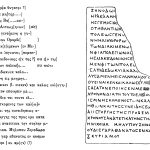| Artefact ID | 1456 |
| TM ID | TM 102272 |
| Findspot (DEChriM ID) | - () | Class | Textual |
| Material | Stone |
| Writing medium | Inscription |
| Text content | Documentary |
| Language | Greek |
| Description | IGChrEg 70, CGC 9282: Funerary Epitaph for Zenodora |
| Selection criteria | Christian terms/formulas/concepts |
| Date from | 300 |
| Date to | 399 |
| Dating criteria | Cagnat/Besnier 1903 date the inscription to the 5th c., Milne 1905 and Lefebvre 1907 place it in the 4th c. The mentioned legio V Macedonica is presumed to have arrived in Egypt under Galerius at the end of the 3rd c. (293/294, see Zuckermann 1988). |
| Absolute/relative date | Relative date |
| Archaeological context | The inscription was housed in the Egyptian Museum of Antiquities, then at Giza, when first transcribed by de Ricci 1902. He stated the stele might have originated in Saqqāra. |
| Accession number | Cairo, Egyptian Museum CG 9282 |


 Json data
Json data




